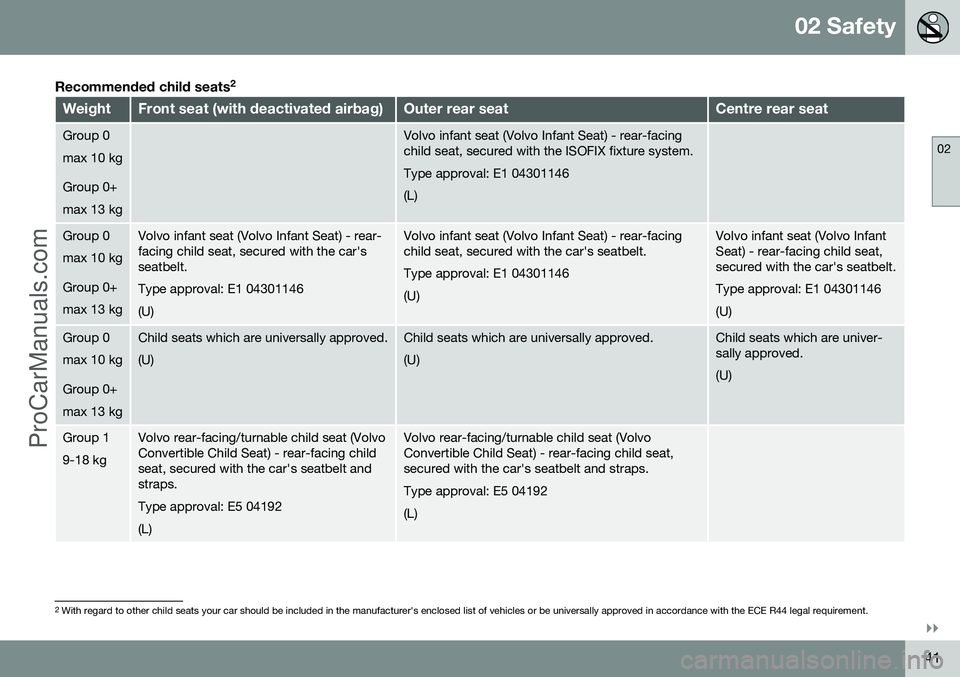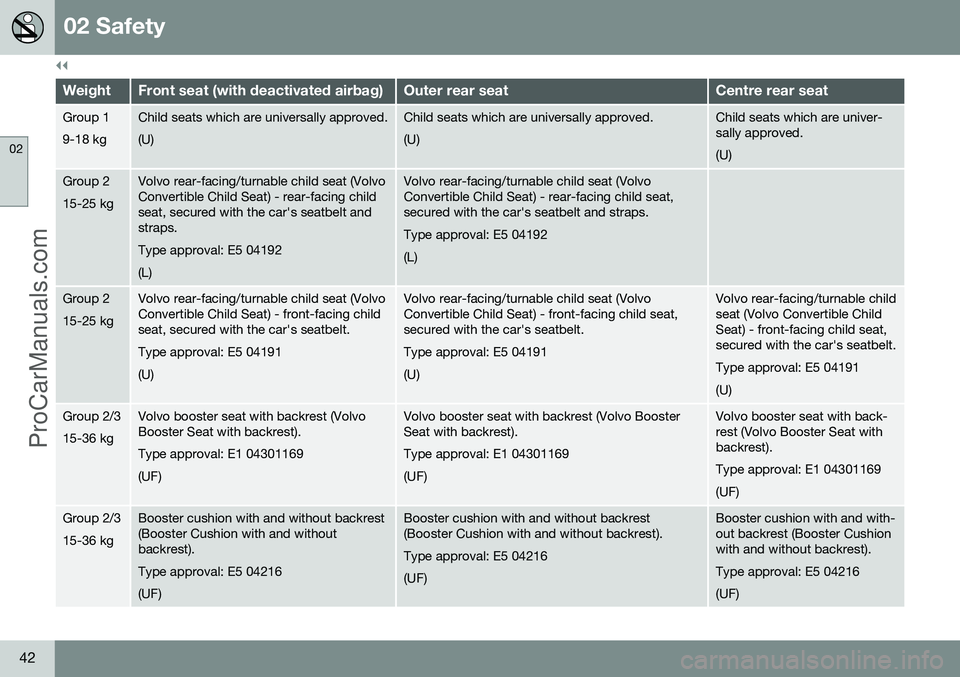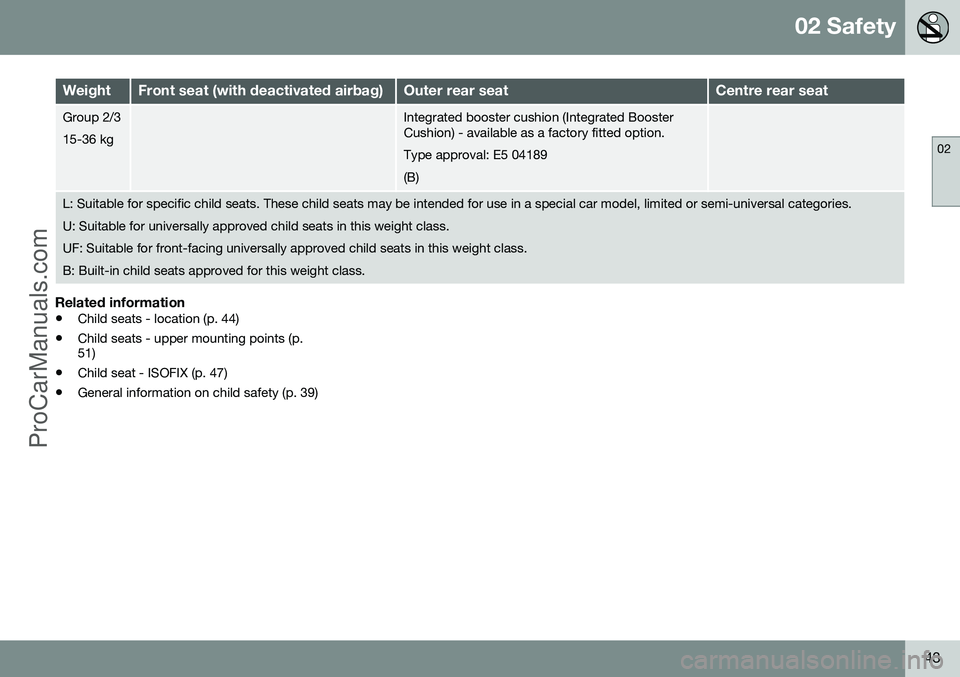2014 VOLVO V60 weight
[x] Cancel search: weightPage 12 of 442

Table of contents
10
11
11 Specifications
Type designations................................... 386
Dimensions............................................. 389
Weights................................................... 390
Towing capacity and towball load.......... 391
Engine specifications.............................. 393
Engine oil - adverse driving conditions... 395
Engine oil - grade and volume................ 396
Coolant - grade and volume................... 398
Transmission fluid - grade and volume... 399
Brake fluid - grade and volume............... 401
Power steering fluid - grade.................... 401
Washer fluid - quality and volume.......... 401
Fuel tank - volume.................................. 402
Fuel consumption and CO2 emissions... 403
Tyres - approved tyre pressures............. 407
Electrical system..................................... 410
Starter battery - specification................. 411Type approval - remote control key sys-
tem.......................................................... 412
Type approval - tyre pressure monitoring 412
Type approval - radar system................. 413 Type approval - Bluetooth®
.................... 414
Licenses.................................................. 422
Symbols in the display............................ 425
12
12 Alphabetical Index
Alphabetical Index.................................. 428
ProCarManuals.co’
Page 38 of 442

02 Safety
02
36
When the systems deploy
In the event of a collision Volvo's different personal safety systems work together inorder to minimise injury.
SystemTriggered
Seatbelt ten- sioner (p. 26) frontseatIn the event of a frontal collision,and/or side-impactcollision, and/or rear-end collision and/oroverturning
Seatbelt tensioner, rear seatIn a frontal collision and/or side-impactaccident and/oroverturning
Airbags (Steering wheel(p. 28) and passengerairbag (p. 29))In a frontal collisionA
Side airbags (SIPS) (p. 31)In a side-impact accident
A
SystemTriggered
Inflatable Curtain IC (p. 33)In the event of a side impact and/or over-turning and/or some frontal collisions A
Whiplash protec- tion WHIPS (p. 33)In a rear-end colli- sion
A
The bodywork of the car could be greatly deformed in a collision without airbag deployment. A number of factorssuch as the rigidity and weight of the object hit, the speedof the car, the angle of the collision etc. affects how thedifferent safety systems of the car are activated.
If the airbags (p. 28) have deployed, the fol- lowing is recommended: • Recovering the car. Volvo recommends that you have it conveyed to an author-ised Volvo workshop. Do not drive withdeployed airbags.
• Volvo recommends that you engage anauthorised Volvo workshop to handle thereplacement of components in the car'ssafety systems.
• Always contact a doctor.
NOTE
The airbags and belt tensioner system are deployed only once during a collision.
WARNING
The airbag system's control module is located in the centre console. If the centreconsole is drenched with water or otherliquid, disconnect the battery cables. Donot attempt to start the car since the air-bags may deploy. Recovering the car.Volvo recommends that you have it con-veyed to an authorised Volvo workshop.
WARNING
Never drive with deployed airbags. They can make steering difficult. Other safetysystems may also be damaged. Thesmoke and dust created when the airbagsare deployed can cause skin and eye irrita-tion/injury after intensive exposure. In caseof irritation, wash with cold water. Therapid deployment sequence and airbagfabric may cause friction and skin burns.
ProCarManuals.co’
Page 41 of 442

02 Safety
02
* Option/accessory, for more information, see Introduction.39
General information on child safety
Children of all ages and sizes must always sit correctly secured in the car. Never allow achild to sit on the knee of a passenger. Volvo recommends that children travel in rear-facing child seats until as late an age aspossible, at least until 3-4 years of age, andthen front-facing booster cushions/child seatsuntil up to 10 years of age. The position of a child in the car and the choice of equipment are dictated by thechild's weight and size; see Child seats (p.40).
NOTE
Regulations regarding the placement of children in cars vary from country to coun-try. Check what does apply.
Volvo has child safety equipment (child seats, booster cushions & attachment devices)which is designed for your particular car.Using Volvo's child safety equipment pro-vides you with optimum conditions for yourchild to travel safely in the car. Furthermore,the child safety equipment fits and is easy touse.
NOTE
In the event of questions when fitting child safety products, contact the manufacturerfor clearer instructions.
Child safety locksThe rear doors and rear door windows* can be blocked manually (p. 169) or electronically(p. 170)* from opening from the inside.
Related information
• Child seats - location (p. 44)
• Child seat - ISOFIX (p. 47)
• Child seats - upper mounting points (p. 51)
ProCarManuals.co’
Page 43 of 442

02 Safety
02
}}
41
Recommended child seats2
WeightFront seat (with deactivated airbag)Outer rear seatCentre rear seat
Group 0 max 10 kg Group 0+ max 13 kgVolvo infant seat (Volvo Infant Seat) - rear-facing child seat, secured with the ISOFIX fixture system. Type approval: E1 04301146(L)
Group 0 max 10 kg Group 0+ max 13 kgVolvo infant seat (Volvo Infant Seat) - rear- facing child seat, secured with the car'sseatbelt. Type approval: E1 04301146(U)Volvo infant seat (Volvo Infant Seat) - rear-facing child seat, secured with the car's seatbelt. Type approval: E1 04301146(U)Volvo infant seat (Volvo Infant Seat) - rear-facing child seat,secured with the car's seatbelt. Type approval: E1 04301146(U)
Group 0 max 10 kg Group 0+ max 13 kgChild seats which are universally approved. (U)Child seats which are universally approved. (U)Child seats which are univer- sally approved. (U)
Group 1 9-18 kgVolvo rear-facing/turnable child seat (Volvo Convertible Child Seat) - rear-facing childseat, secured with the car's seatbelt andstraps. Type approval: E5 04192(L)Volvo rear-facing/turnable child seat (Volvo Convertible Child Seat) - rear-facing child seat,secured with the car's seatbelt and straps. Type approval: E5 04192(L)
2
With regard to other child seats your car should be included in the manufacturer's enclosed list of vehicles or be universally approved in accordance with the ECE R44 legal requirement.
ProCarManuals.co’
Page 44 of 442

||
02 Safety
02
42
WeightFront seat (with deactivated airbag)Outer rear seatCentre rear seat
Group 1 9-18 kgChild seats which are universally approved. (U)Child seats which are universally approved. (U)Child seats which are univer- sally approved. (U)
Group 2 15-25 kgVolvo rear-facing/turnable child seat (Volvo Convertible Child Seat) - rear-facing childseat, secured with the car's seatbelt andstraps. Type approval: E5 04192(L)Volvo rear-facing/turnable child seat (Volvo Convertible Child Seat) - rear-facing child seat,secured with the car's seatbelt and straps. Type approval: E5 04192(L)
Group 2 15-25 kgVolvo rear-facing/turnable child seat (Volvo Convertible Child Seat) - front-facing childseat, secured with the car's seatbelt. Type approval: E5 04191(U)Volvo rear-facing/turnable child seat (Volvo Convertible Child Seat) - front-facing child seat,secured with the car's seatbelt. Type approval: E5 04191(U)Volvo rear-facing/turnable child seat (Volvo Convertible ChildSeat) - front-facing child seat,secured with the car's seatbelt. Type approval: E5 04191(U)
Group 2/3 15-36 kgVolvo booster seat with backrest (Volvo Booster Seat with backrest). Type approval: E1 04301169(UF)Volvo booster seat with backrest (Volvo Booster Seat with backrest). Type approval: E1 04301169(UF)Volvo booster seat with back- rest (Volvo Booster Seat withbackrest). Type approval: E1 04301169(UF)
Group 2/3 15-36 kgBooster cushion with and without backrest (Booster Cushion with and withoutbackrest). Type approval: E5 04216(UF)Booster cushion with and without backrest (Booster Cushion with and without backrest). Type approval: E5 04216(UF)Booster cushion with and with- out backrest (Booster Cushionwith and without backrest). Type approval: E5 04216(UF)
ProCarManuals.co’
Page 45 of 442

02 Safety
02
43
WeightFront seat (with deactivated airbag)Outer rear seatCentre rear seat
Group 2/3 15-36 kgIntegrated booster cushion (Integrated Booster Cushion) - available as a factory fitted option. Type approval: E5 04189(B)
L: Suitable for specific child seats. These child seats may be intended for use in a special car model, limited or semi-universal categories. U: Suitable for universally approved child seats in this weight class.UF: Suitable for front-facing universally approved child seats in this weight class.B: Built-in child seats approved for this weight class.
Related information
•Child seats - location (p. 44)
• Child seats - upper mounting points (p. 51)
• Child seat - ISOFIX (p. 47)
• General information on child safety (p. 39)
ProCarManuals.co’
Page 47 of 442

02 Safety
02
* Option/accessory, for more information, see Introduction.45
Incorrect position, the head restraint must be adjusted as high as the head and the seatbeltmust not be below the shoulder.
Check before driving that:
• the integrated two-stage booster seat is correctly set in accordance with the table(p. 45) and in locked position
• the seatbelt is in contact with the child'sbody and is not slack or twisted
• the seatbelt does not lie across thechild's throat or below the shoulder (seepreceding illustrations)
• the lap section of the seatbelt is posi-tioned low over the pelvis to provide opti-mal protection.
Adjusting the booster seat's two levels is per-
formed by raising (p. 45) and lowering (p. 46).
WARNING
Volvo recommends that repair or replace- ment is only carried out by an authorisedVolvo workshop. Do not make any modifi-cations or additions to the booster cush-ion. If an integrated booster cushion hasbeen subjected to a major load, such as inconjunction with a collision, the entirebooster cushion must be replaced. Even ifthe booster cushion appears to be undam-aged, it may not afford the same level ofprotection. The booster cushion must alsobe replaced if it is heavily worn.
WARNING
If the instructions for the two-stage booster seat are not followed then thechild could sustain serious injury in theevent of an accident.
Two-stage booster seat* - raising
The integrated booster seat (p. 44) in the rear seat can be folded up into two stages. Howmany stages the cushion should be folded updepends on the child's weight.
Stage 1Stage 2
Weight22-36 kg15-25 kg
Stage 1 3
Pull the handle forward and up in order to
release the booster cushion.
3 Lower stage.
ProCarManuals.co’
Page 51 of 442

02 Safety
02
}}
49
ISOFIX - types of child seat
Child seats are in different sizes – cars are in different sizes. This means that not all childseats are suitable for all seats in all car mod-els.
Type of child seatWeightSize classPassenger seats for ISOFIX installation of child seats
Front seatOuter rear seat
Infant seat transversemax 10 kgFXX
GXX
Infant seat, rear-facingmax 10 kgEXOK
(IL)
Infant seat, rear-facingmax 13 kgEXOK(IL)
DXOK(IL)
CXOK(IL)
Child seat, rear-facing9-18 kgDXOK(IL)
CXOK(IL)
ProCarManuals.co’